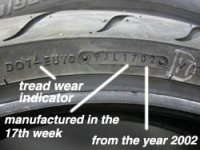Crossroads Trikes
Sponsor - Crossroads Trikes
TIRE SAFETY
Gene Wright
Crossroads Trikes and Trailers
We want all of our Trike Talk friends to ride safe. Knowing you are depending on those narrow strips of rubber that are your interface with the highway, we want to do everything we can to make sure those tires are as safe as they can be.
Several factors need to be continually monitored:
· Tire Pressure.
If the tires are underinflated the sidewalls will flex more than they are designed for. This flexing wears out the tire sidewall prematurely and causes heat build-up in the tire. Either of these can cause the tire to fail catastrophically. Over inflation can also be dangerous. It is important to monitor the pressure in your tires. When riding around town, you should check the tire pressure each time you ride. On longer trips you should check tire pressure every time you stop for gas. One fairly new apparatus is a Tire Pressure Monitoring System (TPMS).
If your motorcycle doesn’t have TPMS one is available and easily installed on your motorcycle. TPMS for a two wheel motorcycle costs approximately $150 to $200. For a trike or two-wheeler/trailer combination a TPMS system will cost approximately $250 to $300. Tire pressure is transmitted to, and can be continually monitored on a key fob, a GPS or a handlebar mounted receiver, depending on the brand and model of the TPMS.
· Tire Tread.
Many states hve a legal minimum tread depth for tires. The minimum legal tire tread depth in Utah is 2/32 inch. Replacing tires before they get to the minimum depth is a good idea to maintain maximum traction and to lessen the chance of hydroplaning.
· Tire damage.
Check your tires frequently for cuts, exposed cords and other damage.
·Tire age.
Here at Crossroads Trikes we give tires to the recycler at 5 years from the manufacturing date. This a little conservative, but industry practice is to recycle tires at 7-8 years from the manufacturing date.
The remaining tread is of no importance when the tire “ages-out”. I speak from personal experience having blown, in a very dicey situation, a perfectly good appearing tire that got too old.
Here is how you find the manufacturing date:

Look on the side for a raised block with four digits; it's usually next to the U.S. DOT tire identification number. The first two indicate the week of its manufacture, and the last two are for the year. For example, 1702 would indicate the tire was manufactured in April, 2002. Prior to 2000, there were only three digits, with the last one indicating the year.
We wish all of our Trike Talk friends many happy miles of safe riding!
Gene Wright
Crossroads Trikes and Trailers
We want all of our Trike Talk friends to ride safe. Knowing you are depending on those narrow strips of rubber that are your interface with the highway, we want to do everything we can to make sure those tires are as safe as they can be.
Several factors need to be continually monitored:
· Tire Pressure.
If the tires are underinflated the sidewalls will flex more than they are designed for. This flexing wears out the tire sidewall prematurely and causes heat build-up in the tire. Either of these can cause the tire to fail catastrophically. Over inflation can also be dangerous. It is important to monitor the pressure in your tires. When riding around town, you should check the tire pressure each time you ride. On longer trips you should check tire pressure every time you stop for gas. One fairly new apparatus is a Tire Pressure Monitoring System (TPMS).
If your motorcycle doesn’t have TPMS one is available and easily installed on your motorcycle. TPMS for a two wheel motorcycle costs approximately $150 to $200. For a trike or two-wheeler/trailer combination a TPMS system will cost approximately $250 to $300. Tire pressure is transmitted to, and can be continually monitored on a key fob, a GPS or a handlebar mounted receiver, depending on the brand and model of the TPMS.
· Tire Tread.
Many states hve a legal minimum tread depth for tires. The minimum legal tire tread depth in Utah is 2/32 inch. Replacing tires before they get to the minimum depth is a good idea to maintain maximum traction and to lessen the chance of hydroplaning.
· Tire damage.
Check your tires frequently for cuts, exposed cords and other damage.
·Tire age.
Here at Crossroads Trikes we give tires to the recycler at 5 years from the manufacturing date. This a little conservative, but industry practice is to recycle tires at 7-8 years from the manufacturing date.
The remaining tread is of no importance when the tire “ages-out”. I speak from personal experience having blown, in a very dicey situation, a perfectly good appearing tire that got too old.
Here is how you find the manufacturing date:

Look on the side for a raised block with four digits; it's usually next to the U.S. DOT tire identification number. The first two indicate the week of its manufacture, and the last two are for the year. For example, 1702 would indicate the tire was manufactured in April, 2002. Prior to 2000, there were only three digits, with the last one indicating the year.
We wish all of our Trike Talk friends many happy miles of safe riding!






